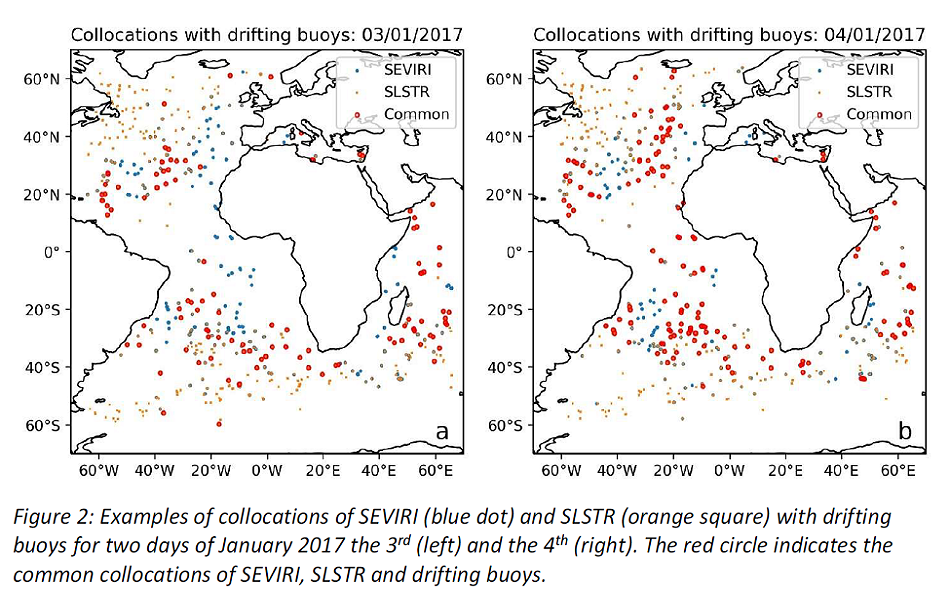08/03/2022
Comparison of SSTs from SEVIRI and SLSTR satellite instruments over collocations with drifting buoys
-
The intercomparison between sensors is crucial for assessing the quality of Sea Surface Temperature (SST) datasets. In the context of the OSI SAF Visiting Scientist Program, Christoforos Tsamalis from the Met Office Hadley Centre, worked on the Comparison of Sea Surface Temperature from SEVIRI and SLSTR satellite instruments over collocations with drifting buoys. This work took place in 2019 and was supervised by Stéphane Saux-Picart and Hervé Roquet (Météo-France).
-
The results show that SLSTR SST (quality level 5) compares really well with drifting buoys, although there are some remaining dependencies with total column water vapour during day and probably with dust aerosols. The SEVIRI results against drifting buoys (quality levels 3 to 5) are in line with previous studies.
-
Objectives and framework of the study
In this study, the SST from SEVIRI, SLSTR, drifting buoys and OSTIA (only during night) have been intercompared over common collocations covering a 3-year period (1/8/2016-31/7/2019). This way, the number of collocations is reduced significantly, as both satellite instruments have to provide cloud-free SSTs during the overpass time of SLSTR (being the satellite instrument on a polar orbit).
Mainly results from robust statistics have been provided, which are more resilient to outliers and to noisy data. The reference SST dataset has been chosen to be the drifting buoys (as in situ instruments), which measure depth SST. In the interpretation of the results, one needs to take into account that SLSTR measures skin SST, thus a difference with drifting buoys observations is expected, but both SEVIRI and OSTIA (during night) should agree rather closely with the drifting buoys on average. In the analysis of the results, daytime and night time conditions have been examined separately.
SLSTR is a dual view sensor offering high quality radiometric data and high quality SST products. Comparison of SLSTR SST with OSI SAF lower resolution SEVIRI product is aimed to identify perspectives for improvement. SLSTR and SEVIRI instruments are different sensors on different satellite orbits and have different resolutions. The objective is to compare the SST trends with regards to a common reference set as the drifting buoys and observe if similar features and biases can be found in measurement from the different sensors.
-
Report conclusions
- The main part of the analysis performed with SEVIRI quality levels 3 to 5 and SLSTR quality level 5, following the advice from OSI SAF and EUMETSAT, respectively. It turns out that the common collocations are as close as possible in space and time in general within ±3 km and ±60 min, while in the case of SLSTR with drifting buoys the distance is even tighter being in general within ±1 km. This translates to minimal collocation uncertainties.
- SEVIRI and SLSTR are different instruments on different satellite platforms : respectively, geostationary satellite and polar orbiter. The objective is to compare the SST trends with regards to a common reference.
-
- The histograms of the SST difference against drifting buoys have a Gaussian shape with median ± robust standard deviation for SLSTR -0.06±0.24 K and for SEVIRI 0.06±0.42 K during daytime. During night, the respective results are for SLSTR -0.17±0.22 K, for SEVIRI -0.04±0.44 K and for OSTIA -0.09±0.25 K.
- Both OSTIA and SLSTR have very similar performance against drifting buoys, but one has to bear in mind that the collocation uncertainty is larger in the case of OSTIA due to the larger spatial resolution than SLSTR, and that OSTIA system assimilates drifting buoys measurements.
- SEVIRI results indicate a poorer performance against drifting buoys in comparison to SLSTR or OSTIA, but these are in agreement with the OSI SAF validation results for it (Saux-Picart and Marsouin, 2018).
- As expected, the robust standard deviation of SLSTR dual view retrievals (D2 and D3) are better (0.21 K) than for nadir view only with N3 being 0.24 K and N2 being 0.28 K, although their standard deviations are almost the same (0.34-0.35 K).
-
Benefits for the SAF
- The results show that SLSTR SST (quality level 5) compares really well with drifting buoys, although there are some remaining dependencies with total column water vapour during day and probably with dust aerosols. There is also indication of cloud contamination, while according to expectations dual view retrievals perform better than single view. However, the current SLSTR SST does not match yet the quality of AATSR, despite being significantly improved in comparison to previous releases.
- The SEVIRI results against drifting buoys (quality levels 3 to 5) are in line with previous studies. More specifically, there is clear dependence on zenith angle, indicating that the retrieval is suboptimal especially at high angles, probably not correcting entirely for water vapour at high optical paths. This agrees with the dependence that SEVIRI shows on total column water vapour. In addition SEVIRI SST quality decreases as the Saharan Dust Index becomes more positive, indicating an impact of dust load, although this is less obvious when using the SLSTR Aerosol Dynamic Indicator as metric of dust presence.
- The statistics of OSTIA are similar to SLSTR, especially the standard deviations. Nevertheless, OSTIA has a stronger dependence on dust aerosols than SEVIRI or SLSTR and it depends on total column water vapour. It is hypothesised that both these dependencies are inherited from VIIRS, which is used as reference in OSTIA.
- The software for the creation of the common collocation database, containing daily netCDF files, is written in Python. Both the software and the database have been delivered to OSI SAF.
-
Report on this study
-
Authors
Christoforos Tsamalis, Met Office Hadley Centre, UK




